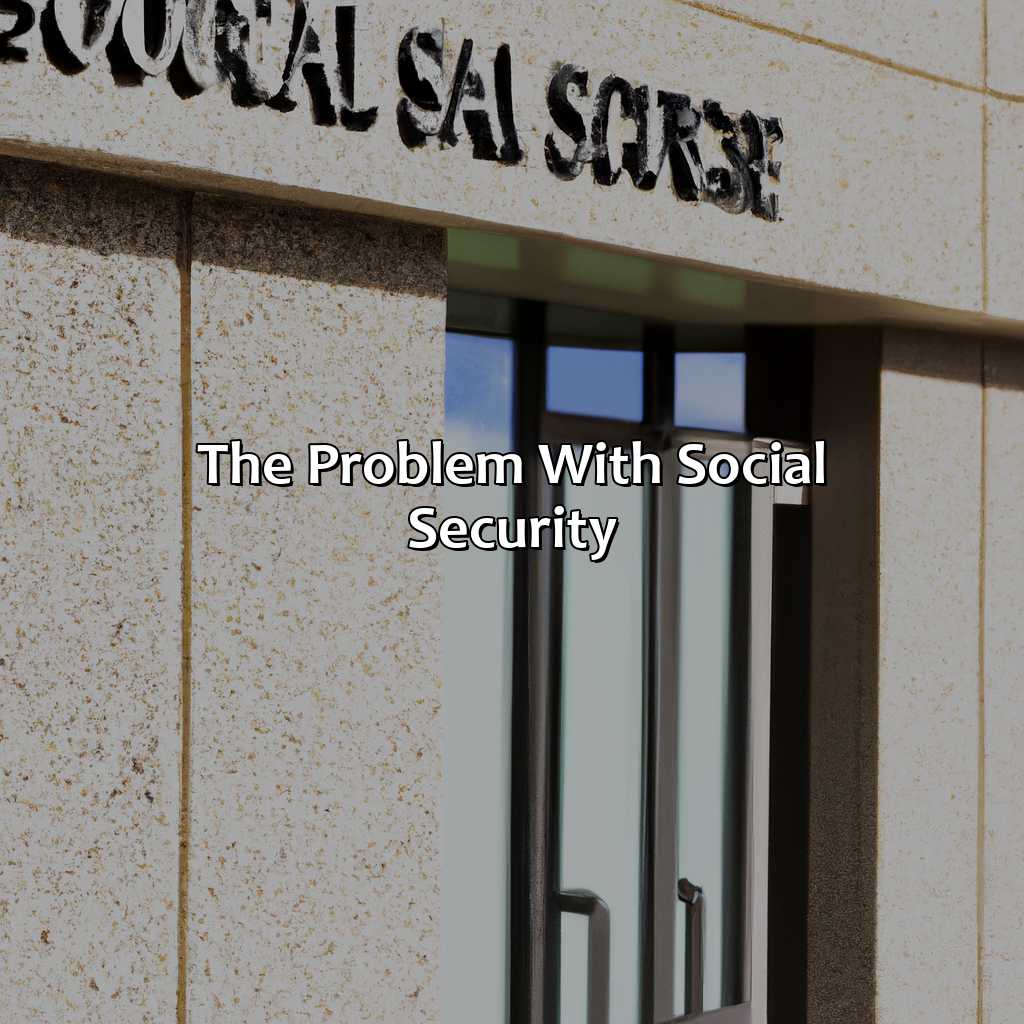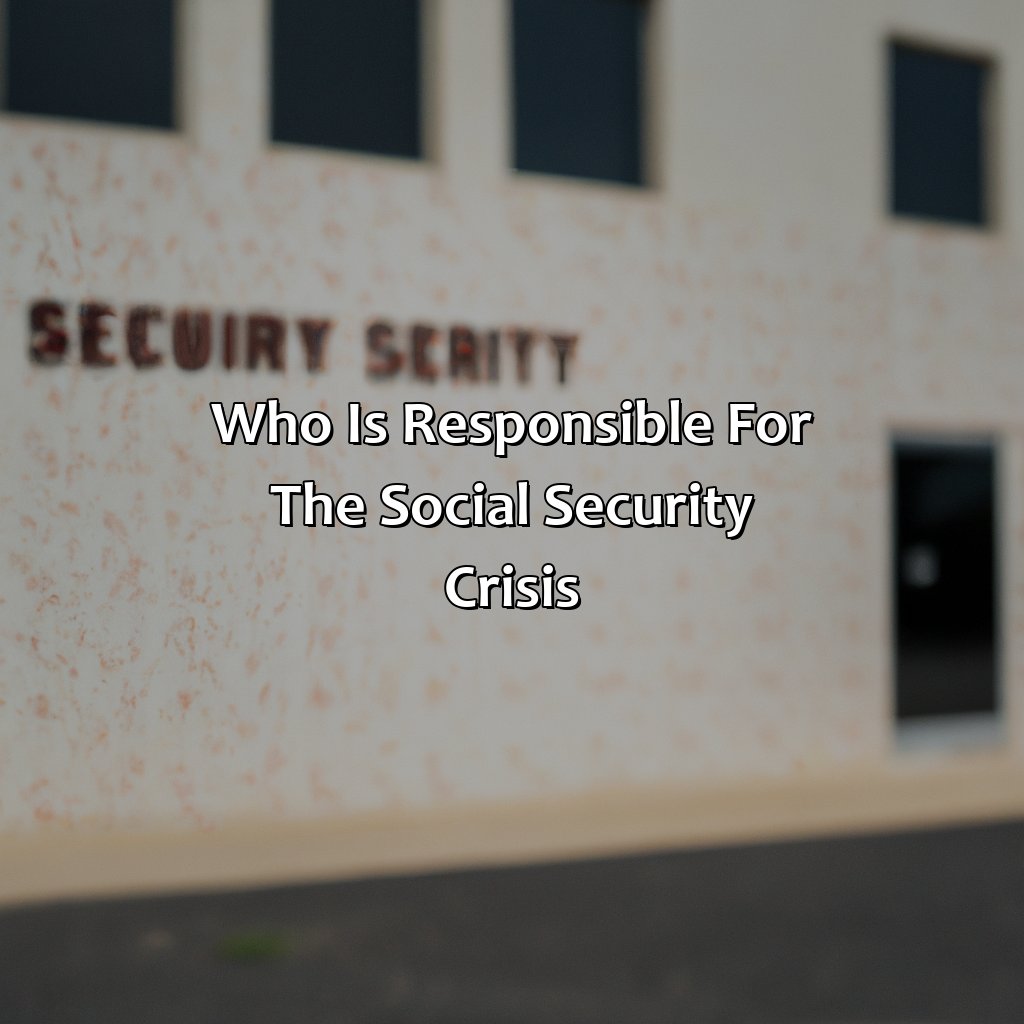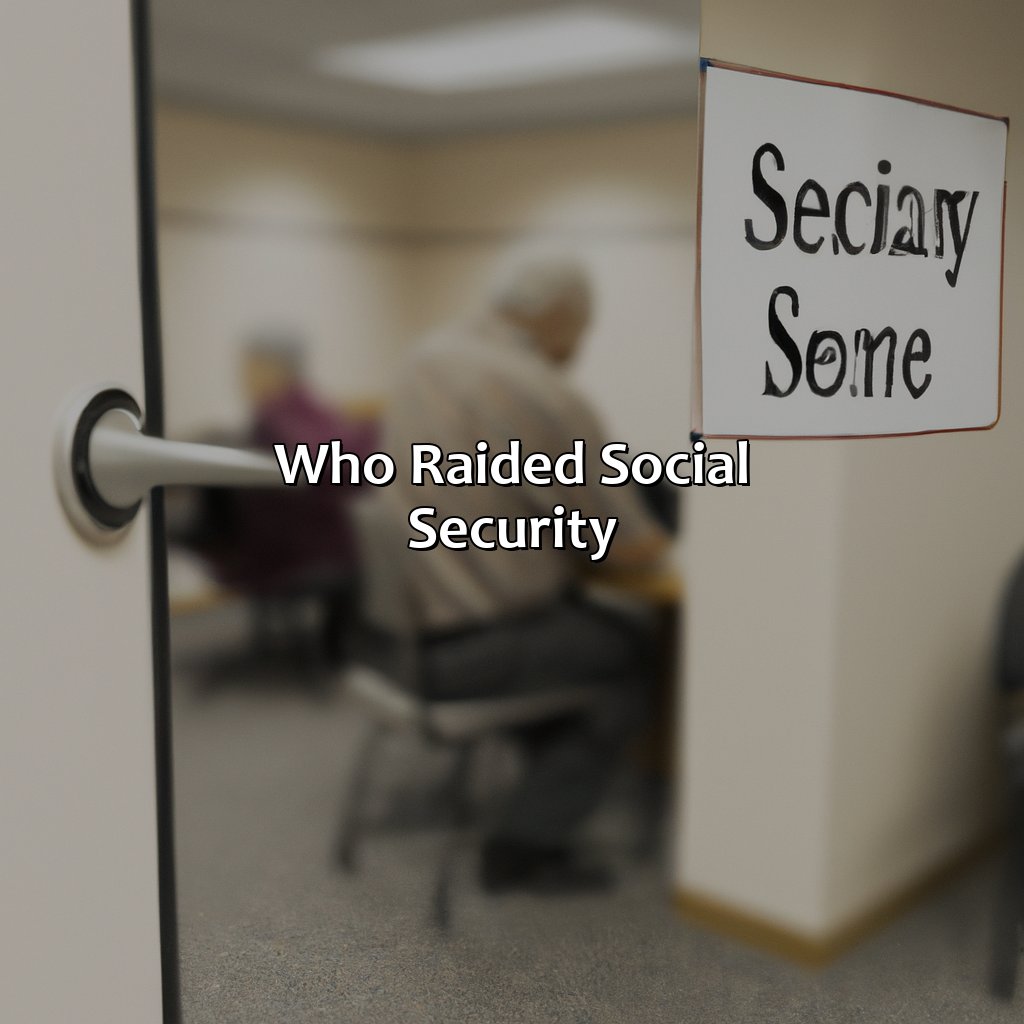Who Raided Social Security?
Key Takeaway:
- The Social Security crisis is attributed to low funding, trust fund mismanagement, and changes in demographics and economy.
- The government, politicians, and American citizens are all responsible for the Social Security crisis.
- Possible solutions to the crisis include increasing taxes, raising retirement age, reducing benefits, and privatization of Social Security.
Have you ever wondered who raided social security? You are not alone. Discover the truths behind the social security crisis and find out how to protect your future.
The Problem with Social Security
To comprehend “The Problem with Social Security“, we must first understand the issues that affect its long-term solvency. This includes:
- Low Funding
- Trust Fund Mismanagement
- Changes in Demographics
- Changes in the Economy
These sub-sections reveal the core challenges of the United States social security system and its ability to provide benefits to future generations.

Image credits: retiregenz.com by Harry Jones
Low Funding
The inadequacy of resources in the Social Security system is a significant concern that needs attention. The available funds are inadequate to cater to the increasing number of beneficiaries. This problem stems from several factors, including demographic factors and economic changes resulting in fiscal deficits.
The insufficient funding has led to an imbalance in the Social Security trust fund, with projections showing that it could run out by 2035. This issue puts at risk retirement benefits for millions of Americans. As such, policymakers must address this issue urgently by implementing reforms such as increasing contributions or reducing benefits.
One critical factor contributing to low funding is the ongoing discussion surrounding who raided Social Security’s coffers. Some argue that politicians misappropriated funds for other programs, leading to a shortfall in the trust fund. However, others disagree on who is responsible for draining the system’s finances.
It’s imperative to understand how low funding affects individuals. Consider a retiree relying on social security payments to meet their basic needs; inadequate funding will impact their quality of life and negatively affect their financial stability. It’s concerning, particularly when those who have paid into the system aren’t receiving what they were promised.
Looks like the only trust Social Security can rely on is the one where you give your money to a friend to hold onto, and hope they don’t spend it on avocado toast.
Trust Fund Mismanagement
The mismanagement of the Social Security Trust Fund has become a major problem. There has been an inadequate contribution to the fund by taxpayers, coupled with excessive withdrawals to finance other federal programs. In turn, this has resulted in a bleak future for those who depend on Social Security benefits.
To compound matters, there is no clear plan to overhaul the system and ensure its long-term sustainability. The result is a system that is teetering on the brink and looks set to run out of funds in the coming years.
Amidst all this, it is unclear who raided social security. While both political parties are responsible for robbing the trust fund, little progress has been made towards finding solutions and locating accountability.
Pro Tip: To ensure your Social Security benefits are maximized, be proactive in monitoring changes in the system and educate yourself on available options for retirement planning.
Looks like Social Security has a greater chance of drying up than the Aral Sea with these changes in demographics and economy.
Changes in Demographics and Economy
The dramatic shifts in societal demographics and economic developments have impacted Social Security’s stability. Unprecedented demographic changes have resulted in the shrinking of the working-age population, while the elder community continues to grow. In addition, increased longevity rates place an overwhelming burden on retirement savings, thereby affecting Social Security’s financial stability.
These factors coupled with specific economic trends pose additional challenges to the Social Security program. For instance, increasing automation and globalization lead to job displacement and slower wage growth for many workers. This phenomenon reduces the overall contribution base supporting Social Security as it directly correlates with wage inequality.
Another factor that compounds this is political interference over several decades. Elected officials have exploited loopholes within Social Security’s structure to allocate funds into non-Social Security programs. Such tactics jeopardize payouts to retirees and those who depend on it for income support.
One such example is when Congress authorized a payroll tax holiday without offsetting it with any alternate revenue source or reducing expenses elsewhere, drawing more than $100 billion from the program’s reserves. Political officials must ensure responsible governance while enacting policy reforms for the greater good of beneficiaries’ retirement security and equity policies for future generations.
A sad truth is that countless retired individuals receive meager pensions despite having contributed their fair share over their workyears – often resorting to food banks to supplement daily living expenses. Policymakers must prioritize protecting these hardworking individuals’ livelihoods through sustainable reform efforts by bridging funding gaps and strengthening accessibility and awareness of available benefits options.
For the social security crisis, we can blame the government for mismanaging funds, Wall Street for gambling with our savings, and maybe even ourselves for not knowing better. But let’s just blame the Kardashians, they’re an easy target.
Who is Responsible for the Social Security Crisis?
Who is accountable for the social security crisis? Break it down!
The Government, Politicians, and American Citizens each hold a piece of this puzzle. Get into the nitty-gritty of the crisis and potential solutions by exploring the ‘Who is Responsible for the Social Security Crisis?’ section. Sub-sections will provide more details!

Image credits: retiregenz.com by Adam Duncun
The Government
Looking into the Social Security crisis, it can be seen that the entity responsible for this situation is none other than the federal government. The government has been using Social Security funds as a means to finance other programs, leading to a lack of funds for future beneficiaries. This unsustainable method of funding needs to be addressed promptly.
The misuse of Social Security funds has been going on for many years and is not a recent development. The government sees it as an easy source of revenue rather than protecting the interests of future retirees. As a consequence, there are concerns over the financial stability of Social Security in the coming years.
It is vital that corrective measures are implemented promptly to prevent further damage to the program’s finances in the future. Apart from addressing funding challenges directly linked with today’s generation, lawmakers should take necessary actions that set more substantial protections in place before utilizing these funds.
According to US News & World Report (2021), “Social Security trust funds will run out by 2034.” It is high time elected officials take action towards ensuring social security remains sustainable and financially stable beyond 2034 through fiscal responsibility and accountability.
“Politicians and diapers have one thing in common – they both need to be changed regularly, and for the same reason.”
Politicians
Elected officials are among those who played a significant role in the social security crisis. The decisions they made over the years on redirecting funds from the social security trust fund to other projects created a shortfall. This disruption has severely impacted the sustainability of the social security program, leaving many Americans uncertain about their financial future.
It is not an exaggeration to say that politicians of both parties have been responsible for taking action years ago to address this issue, but they did not. Instead, they chose short-term gains at the expense of long-term requirements. Efforts should be made to hold elected officials accountable for these failures and incentivize policymakers to look for solutions that prioritize the country’s economic health by ensuring adequate financing for social security.
One way forward may include reversing some of the tax cuts implemented in previous decades and reallocating some government expenditures towards Social Security funding. Clearly, political courage and leadership will be needed to take such initiatives. However, unless Congress addresses this issue comprehensively, America’s robust social safety net will continue to weaken, threatening the well-being of millions of citizens now and into the future.
American citizens may need to start investing in their own retirement plan, because the government seems to think ‘social security‘ means throwing a party for themselves with our money.
American Citizens
The Social Security Crisis is a complex issue that has affected American Citizens due to various factors such as inadequate funds and reduced benefits. Many people believe that the government is responsible for raiding social security funds, causing the crisis. However, the situation is not that simple, and it’s crucial to understand the different parties involved.
- Legislators are accountable for crafting and passing laws related to social security. They make decisions regarding benefit levels, eligibility criteria and retirement age, all of which can affect the program’s sustainability. The government also plays a role in managing the trust fund responsible for receiving and disbursing Social Security payments.
- Social Security beneficiaries themselves have some responsibility in managing their retirement savings. Many Americans rely solely on social security benefits despite knowing that these benefits are not sufficient, making it critical for individuals to adopt other forms of long-term savings.
It’s important to note that while many factors contribute to the social security crisis, solutions involve both short-term measures like adjusting tax rates and implementing cost reductions and long-term strategies such as boosting economic growth through job creation or widening the net of eligible workers.
Let’s hope the solution to the social security crisis isn’t just a retirement plan for politicians.
Possible Solutions to Social Security Crisis
To tackle the social security crisis explained in “Who Raided Social Security?”, different solutions can be chosen. These include:
- increasing taxes
- raising the retirement age
- cutting benefits
- privatizing social security
This section will give a short overview of these ideas and how they may help resolve the crisis.

Image credits: retiregenz.com by Adam Washington
Increase Taxes
One potential solution to address the social security crisis is to implement a tax increase. This could involve increasing payroll taxes for employees and employers, or potentially increasing the taxable wage base. By generating additional revenues through tax increases, social security could remain sustainable over the long term. Additionally, this approach could help to mitigate concerns around benefit reductions that may be required in the absence of sufficient revenue streams. However, it’s important to note that this approach may be unpopular with some individuals who prefer lower taxes or believe that existing tax rates are already too high.
In order to successfully implement a tax increase, policymakers would need to navigate complex political dynamics and gauge public perception of any proposed changes. Policymakers may also need to consider the potential implications of raising taxes on individuals with low or moderate incomes who currently rely on social security benefits. Any proposed changes would likely require careful consideration and collaboration between government officials, social security administrators, and relevant stakeholders.
It’s worth noting that while tax increases could serve as a short-term fix for the social security system, additional solutions will likely be needed over the long term to ensure its continued sustainability. Solutions such as gradually increasing the retirement age or implementing new sources of revenue could also play a role in addressing this critical issue.
Regardless of the specific solutions pursued, it’s clear that action is needed to address the current state of social security and ensure its longevity for generations to come. The implementation of tax increases represents one possible avenue for achieving these goals – but policymakers must carefully balance competing priorities in order to do so effectively.
If we raise the retirement age any higher, seniors will be more likely to celebrate their birthdays at work than with cake and candles.
Raise Retirement Age
With increasing concerns about the sustainability of social security, it has been proposed to enhance the retirement age. This is intended to ease the financial burden on the program by delaying when individuals begin receiving benefits.
However, this solution may have negative impacts on certain groups such as those who work in physically demanding jobs as they may not be able to continue working until an older age. Additionally, raising the retirement age disproportionately affects low income and minority workers who have a shorter life expectancy than their higher-income counterparts.
It is worth noting that while politicians and policymakers often use social security funds for other programs, no one has ‘raided’ social security. These funds are managed by the Social Security Administration and invested in government securities.
According to a report by The Hill, “Social Security’s trustees predict that without changes, the system will be able to pay only 76 percent of promised benefits starting in 2034.” Thus, solutions need to be identified and implemented soon to prevent harmful repercussions and ensure sustainable support for American retirees.
The only thing social security is reducing these days are our expectations for retirement.
Reduce Benefits
Reducing Social Security Benefits is an Option
Social Security benefits can be reduced to save the system from an impending crisis. Here are three possible solutions:
- Adjusting retirement age: Increasing retirement age by a few years could ensure that Social Security has more time to balance its financial books without reducing benefits.
- Means Testing: Gradually phasing out benefits for high-income earners above a certain threshold can ensure the needy get more help.
- Benefit Reduction Formula: Reducing benefits using a benefit reduction formula, ensuring that those who receive higher benefits are subjected to a larger percentage of reduction.
While beneficiaries might resist any changes to the Social Security program, some form of action must be taken to prevent an even greater crisis down the line. It is no secret raids from Congress on Social Security surplus funds have depleted the program’s reserves and triggered criticism from retirees.
It was a dark day in 1983 when Ronald Reagan signed into law legislation directing surplus funds collected in Social Security trust funds to be used for other purposes. Such actions over the years have worsened and hastened up the already bleak outlook for this critical program, making it essential we find new ways to get it back on track before it hits rock bottom. The only thing scarier than trusting the government with our Social Security is trusting Wall Street with it.
Privatization of Social Security
One proposal for addressing the Social Security crisis is the possibility of transferring responsibility for Social Security benefits to private individuals or entities. This would be a significant shift in the current federal system, where Social Security is funded by payroll taxes and managed by the government. The proposed Privatization of Social Security raises many questions about how such a system would work, who would manage it, and what types of investment options would be available.
Under a privatized system, individuals would have more control over their retirement savings and could potentially earn higher returns through investment in stocks and other securities. There are concerns, however, about how such investments would be managed and regulated to protect people from financial risks that could permanently harm their retirement funds.
Interestingly, proposals for Social Security privatization have been around since at least the 1980s but never came to fruition. Some politicians and commentators believe that these proposals were thwarted by special interest groups that wanted to keep the current government-managed system in place.
The history of this issue highlights the competing interests involved in reforming Social Security. While individual retirees may benefit from greater flexibility and potential growth under a privatized system, others argue that this could put vulnerable populations at risk and lead to inequities in retirement savings access based on socioeconomic status.
Some Facts About Who Raided Social Security:
- ✅ In the 1980s, President Ronald Reagan and Congress raided the Social Security trust fund to help balance the federal budget. (Source: Forbes)
- ✅ The amount taken from the Social Security trust fund was over $2 trillion. (Source: Investopedia)
- ✅ The raid on Social Security funds has contributed to its current financial instability. (Source: Center on Budget and Policy Priorities)
- ✅ Many experts predict that the Social Security trust fund will run out of money in the coming decades. (Source: AARP)
- ✅ The raid on Social Security funds is widely viewed as a political move with long-term consequences for retirees and those relying on Social Security benefits. (Source: The New York Times)
FAQs about Who Raided Social Security?
Who raided social security?
The term “raided” refers to the diversion of Social Security funds for purposes outside of the program’s intended use. In the past, Congress has reallocated funds from the Social Security trust fund to other areas of the federal budget. This is commonly referred to as “raiding” Social Security.
When did the raiding of social security happen?
The first major raid on Social Security occurred in 1983 when Congress reallocated funds to pay for other government programs. Since then, Social Security has been raided many times, with both Democratic and Republican administrations using the money for other purposes.
How much money has been raided from social security?
The exact amount of money that has been raided from Social Security is difficult to determine. However, estimates suggest that over $2.9 trillion dollars has been diverted from Social Security over the years.
Does raiding social security affect my benefits?
Raiding Social Security does not directly impact individual benefits. However, if the funds in the trust fund are drained, there will be less money available to pay benefits in the future. This could lead to benefit cuts or increases in the retirement age for future generations.
Can social security be raided again in the future?
Yes, Social Security can be raided again in the future. Congress has the power to reallocate funds from the trust fund, and past actions indicate that this is likely to happen again, given the current political climate and increasing demands on the federal budget.
What can I do to prevent social security from being raided?
Citizens concerned about protecting Social Security from future raids can contact their representatives in Congress and urge them to oppose attempts to reallocate funds from the trust fund. They can also support advocacy groups that work to protect Social Security, and stay informed about legislative changes that could impact the program.


